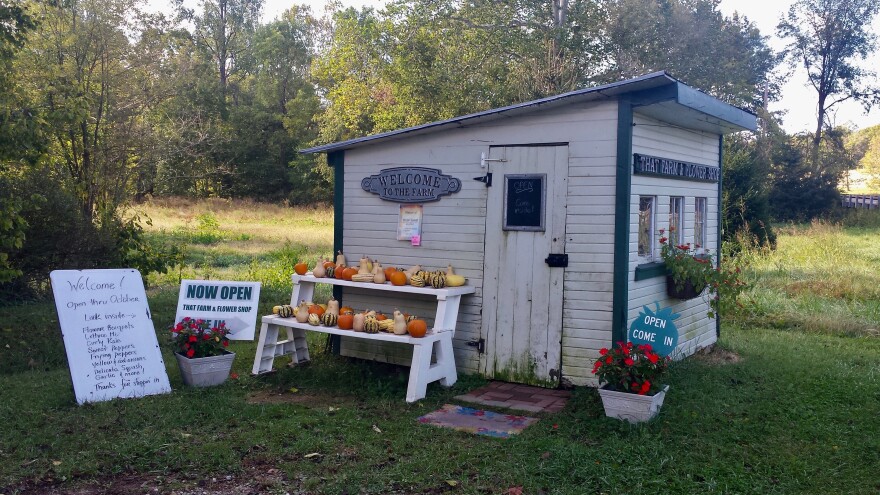Jackie Hampton has pulled up to a small, self-serve, farm stand. It houses seasonal produce from That Guy’s Farm and floral bouquets from That Girl’s Flowers. She’s here to buy flowers for her daughter’s anniversary.
“Actually this is my first time. I’ve always bought their produce and stuff.” Jackie says looking opening the door to the small, refrigerated building, “ They have beautiful flowers. You don’t see this kind in the stores.”
In 2013, Debra Prinzing published a book called ‘Slow Flowers: Four Seasons of Locally Grown Bouquets From the Garden, Meadow and Farm,” launching a movement that is quickly gaining momentum across the country. The idea behind Slow Flowers, is the same as the Slow Food movement: buying flowers that are locally sourced and in season.

The Slow Flower website lists around 620 members which 620 members in the United States who are "slow" growers, florists, wholesalers, online retailers - twelve of those growers are in Ohio - including That Girl’s Flowers, owned by Nellie Ashmore. Nellie grew up on her parents farm, called That Guy’s Family Farm, where they grew produce and flowers. As time went by, Nellie took over the flower growing and created her own business called That Girls Flowers. She grows around two acres of flowers every year on the farm in Blanchester, just north of Cincinnati in Clinton County.
“What I’m most appreciative of is how much support our farm has been given by the community around here,” Nellie says, “It’s just really amazing.”
In 1991, President George Herbert Walker Bush was looking for ways to stem the illegal drug trade in Colombia, by giving more incentives for legal trade. As a result, the 6 percent import duty on Colombian flowers disappeared - and over the next few years - so did over half of the U.S. flower farms. Colombia now makes up 80% of the flowers sold in the United States.
When South America overtook the U.S. floral industry, bouquets became very generic. Roses, lilies, fressia, and carnations are staples. That’s because these are flowers that can survive the rough handling and long shipping process - going from the fields of South America by plane to Miami, where they are stored in warehouses, and then shipped by trucks across the U.S.. The ‘Slow Flower’ movement has opened up an eager market for more unique flowers and creative bouquets that utilize seasonal flowers and local foliage.
“It’s really overwhelming how many people actually buy flowers, and want to buy flowers, and care that the flowers that I grow are unique, and fresh, and one of a kind,” says Nellie.

Barking farm dogs announce the arrival of Rosealie and Katie. New Yorkers that have come back to Ohio to get married tomorrow.
“We googled local flowers, Cininnati and That Girl’s Flowers was the first to come up,” Rosealie says. “[We] look for the local flowers. Because we knew we liked flowers but we needed to find a way to do it.”
“Without a huge carbon footprint’” Katie chimes in.

Nellie takes the two women back to her work area in the barn. Buckets full of brightly colored flowers and greenery fill the table.
“We’ve got celosia, zinnias, dahlias and then I did a mixed bucket of dahlias with zinnias and another kind of celosia,” Nellie says going over their wedding order. “And these are your foliage buckets. These are beauty berries, you can see the little berries on it. This is ninebark, this is autumn olive, viburnum and more autumn olive.”
Ninebark, autumn olive, dahlia…..these aren’t plants that the average florist carries. “I think it was so great to find a place like That Girl’s Flowers in Cincinnati because we didn’t know what was available and this is exactly what we were looking for,” Rosealie says, with an ear to ear grin.
The three women carry bucket after bucket of colorful flowers out to the car. These are the last of Nellie’s harvest. There is a frost warning for tonight, and in the morning the fields of flowers will have turned brown and died.
Rosealie and Katie pull away with a car loaded with flowers. “That was a great way to wrap up the season having a customer come and be very happy with their flowers and knowing the last flowers are going to be for someone’s wedding and very special,” Nellie says as she watches them go.
Nellie will spend the winter planning what flowers she and her two employes will plant next year and ordering seeds. In addition to her customers, Nellie supplies seasonal bouquets to Dorothy Lane Markets in the Dayton area and Pippin’s Farm Market in the Cincinnati area. Nellie is part of the Ohio Ecological Food and Farm Association and offers advice to other Slow Flower growers.
County Lines is WYSO's series on rural life, made possible by a grant from Ohio Humanities. This story was created at the Eichelberger Center for Community Voices at WYSO.

Copyright 2019 WYSO


